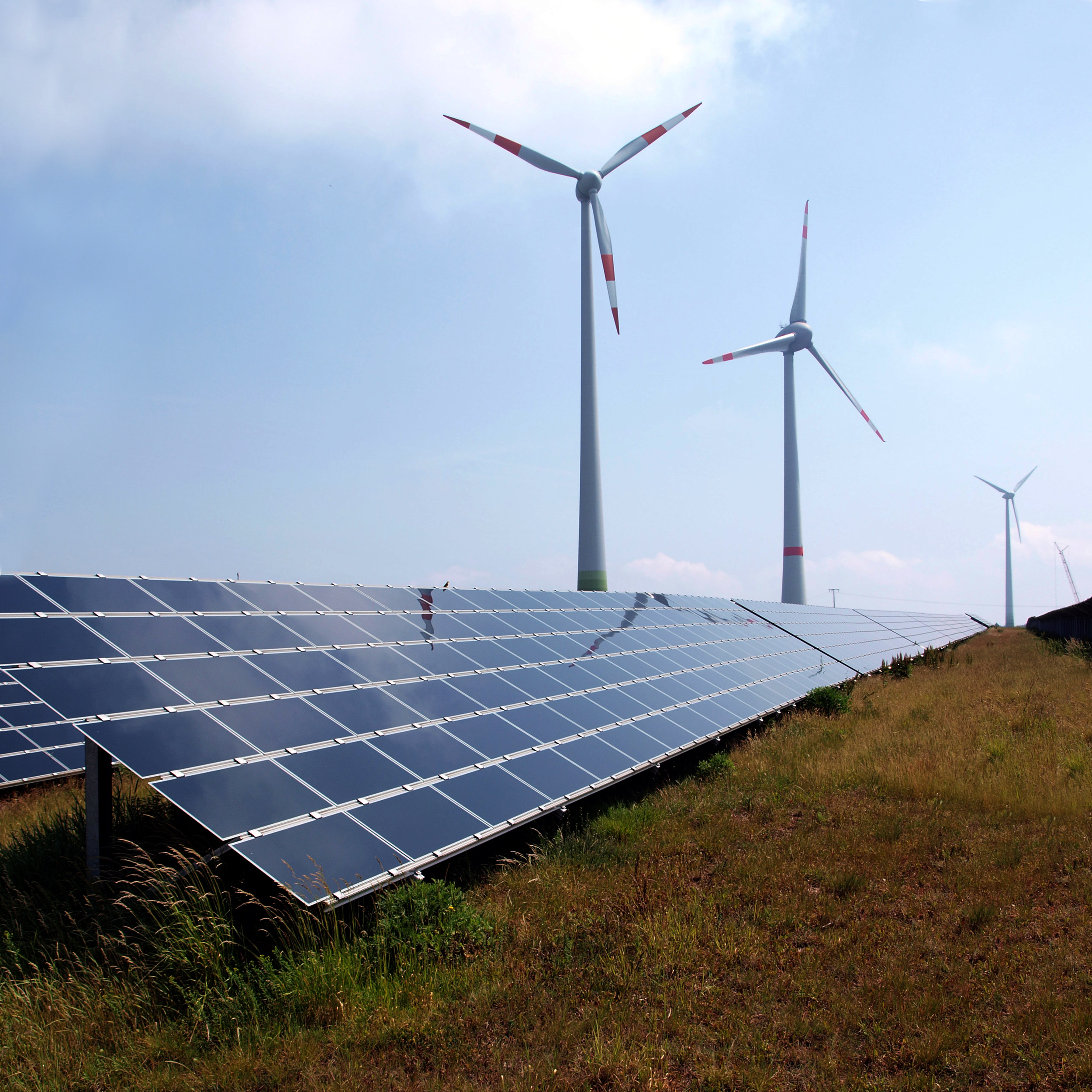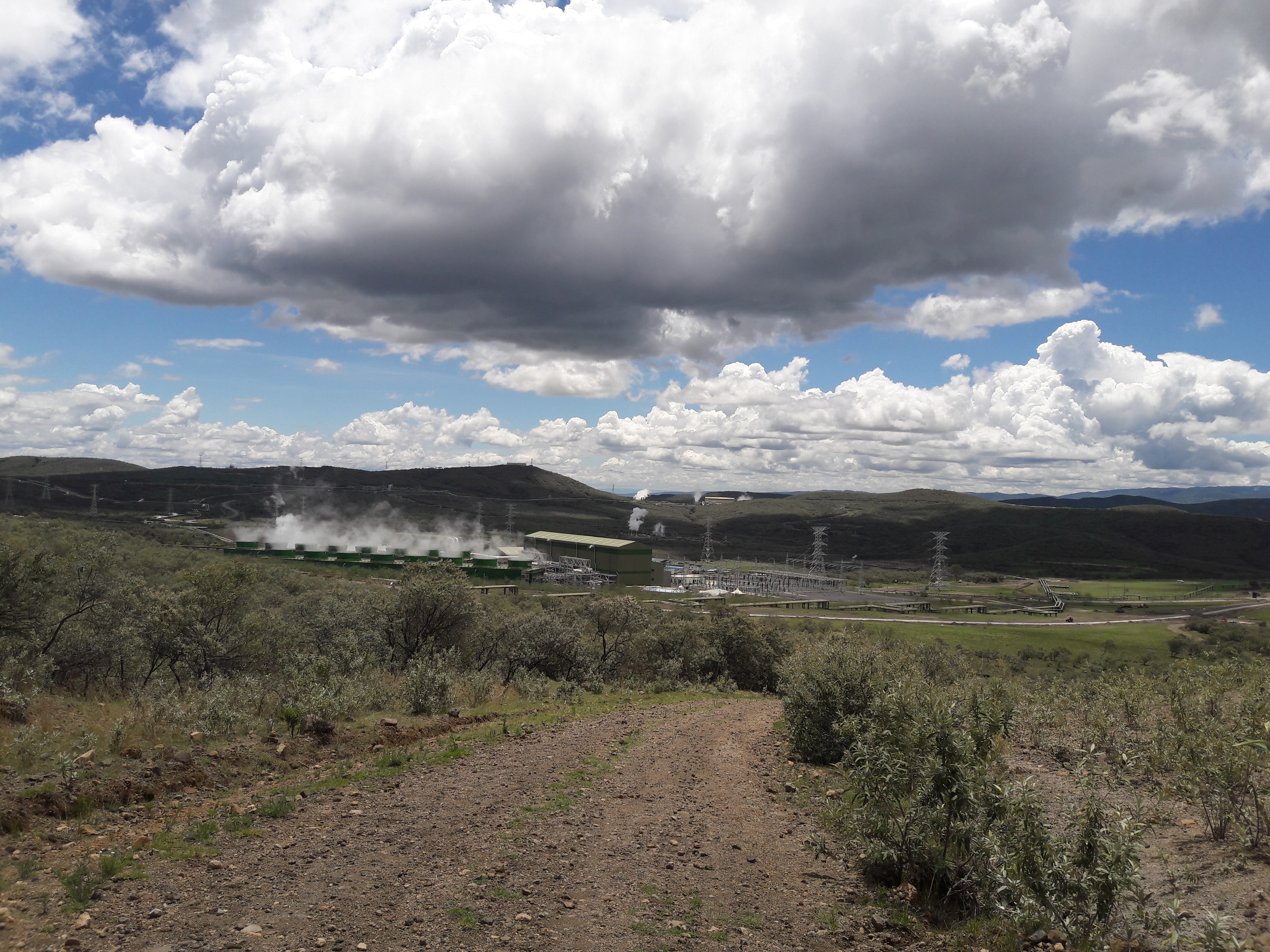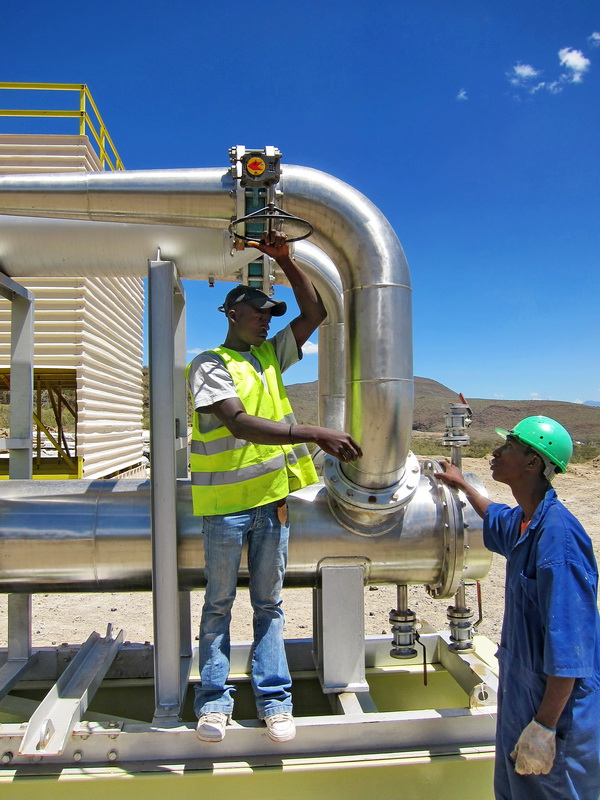|
Wind Power In Kenya
Wind power in Kenya contributes only a small amount of the country's electrical power. However, its share in energy production is increasing. Kenya aims to generate 2,036 MW of wind power, or 9% of the country's total capacity, by 2030. Kenya has two major wind farms, Ngong Hills Wind Farm, located in Ngong, Kajiado County. It produces around 25 MW of electricity. It is owned by Kenya Electricity Generating Company (KenGen) and cost KSh.1.6 billion/= (US$18 million) to construct. The other is Lake Turkana Wind Power Station located in Marsabit County. It generates 310.25 MW of electricity. Notable projects Lake Turkana Wind Power Kenya built the largest wind farm in Africa, the Lake Turkana Wind Power consortium (LTWP). It provides 300 MW of low-cost electrical power. With a projected cost of KSh.70 billion/= (US$800 million), it would be the largest single private investment in Kenya's history. This wind farm would allow Kenya to eliminate its therma ... [...More Info...] [...Related Items...] OR: [Wikipedia] [Google] [Baidu] |
Greenhouse Gas Emissions
Greenhouse gas emissions from human activities strengthen the greenhouse effect, contributing to climate change. Most is carbon dioxide from burning fossil fuels: coal, oil, and natural gas. The largest emitters include coal in China and large oil and gas companies, many state-owned by OPEC and Russia. Human-caused emissions have increased atmospheric carbon dioxide by about 50% over pre-industrial levels. The growing levels of emissions have varied, but it was consistent among all greenhouse gases (GHG). Emissions in the 2010s averaged 56 billion tons a year, higher than ever before. Electricity generation and transport are major emitters; the largest single source, according to the United States Environmental Protection Agency, is transportation, accounting for 27% of all USA greenhouse gas emissions. Deforestation and other changes in land use also emit carbon dioxide and methane. The largest source of anthropogenic methane emissions is agriculture, closely follow ... [...More Info...] [...Related Items...] OR: [Wikipedia] [Google] [Baidu] |
Renewable Energy By Country
This is a list of renewable energy topics by country and territory. These links can be used to compare developments in renewable energy in different countries and territories and to help and encourage new writers to participate in writing about developments in their own countries or countries of interest. The list refers to renewable energy in general, as well as solar power, wind power, geothermal energy, biofuel, and hydro-electricity. As of 2013, China, Germany, and Japan, and India, four of the world's largest economies generate more electricity from renewables than from nuclear power. Based on REN21's 2014 report, renewables supplied 19% of humans' global energy consumption. This energy consumption is divided as 9% coming from traditional biomass, 4.2% as heat energy (non-biomass), 3.8% hydro electricity and 2% is electricity from wind, solar, geothermal, and biomass. China is the world's largest producer of hydroelectricity, followed by Canada, Brazil, India, U.S and Rus ... [...More Info...] [...Related Items...] OR: [Wikipedia] [Google] [Baidu] |
Renewable Energy In Kenya
Kenya Renewable Energy Most of Kenya's electricity is generated by renewable energy sources. Access to reliable, affordable, and sustainable energy is one of the 17 main goals of the United Nations’ Sustainable Development Goals. Development of the energy sector is also critical to help Kenya achieve the goals in Kenya Vision 2030 to become a newly industrializing, middle-income country. With an installed power capacity of 2,819 MW, Kenya currently generates 826 MW hydroelectric power, 828 geothermal power, 749 MW thermal power, 331 MW wind power, and the rest from solar and biomass sources. Kenya is the largest geothermal energy producer in Africa and also has the largest wind farm on the continent ( Lake Turkana Wind Power Project). In March 2011, Kenya opened Africa's first carbon exchange to promote investments in renewable energy projects. Kenya has also been selected as a pilot country under the Scaling-Up Renewable Energy Programmes in Low Income Countries Programme to ... [...More Info...] [...Related Items...] OR: [Wikipedia] [Google] [Baidu] |
List Of Power Stations In Kenya ...
The following page lists power stations in Kenya. Geothermal Hydroelectric Fossil fuels: oil, coal, and gas Wind Solar See also * Energy in Kenya * List of largest power stations in the world * List of power stations in Africa References External links Kenya Electricity Hydro-Power Generation to Fall to 45% in 2014 {{Power stations Kenya Power stations A power station, also referred to as a power plant and sometimes generating station or generating plant, is an industrial facility for the generation of electric power. Power stations are generally connected to an electrical grid. Many po ... [...More Info...] [...Related Items...] OR: [Wikipedia] [Google] [Baidu] |
Hydroelectric Power In Kenya
Kenya Renewable Energy Most of Kenya's electricity is generated by renewable energy sources. Access to reliable, affordable, and sustainable energy is one of the 17 main goals of the United Nations’ Sustainable Development Goals. Development of the energy sector is also critical to help Kenya achieve the goals in Kenya Vision 2030 to become a newly industrializing, middle-income country. With an installed power capacity of 2,819 MW, Kenya currently generates 826 MW hydroelectric power, 828 geothermal power, 749 MW thermal power, 331 MW wind power, and the rest from solar and biomass sources. Kenya is the largest geothermal energy producer in Africa and also has the largest wind farm on the continent ( Lake Turkana Wind Power Project). In March 2011, Kenya opened Africa's first carbon exchange to promote investments in renewable energy projects. Kenya has also been selected as a pilot country under the Scaling-Up Renewable Energy Programmes in Low Income Countries Programme to ... [...More Info...] [...Related Items...] OR: [Wikipedia] [Google] [Baidu] |
Geothermal Power In Kenya
Geothermal power is very cost-effective in the Great Rift Valley of Kenya, East Africa. , Kenya has 690 MW of installed geothermal capacity. Kenya was the first African country to build geothermal energy sources. The Kenya Electricity Generating Company, which is 74% state-owned, has built three plants to exploit the Olkaria geothermal resource, Olkaria I (185 MW), Olkaria II (105 MW) and Olkaria IV (140 MW), Olkaria V (160 MW), 75 MW Wellhead generation plants, with a third private plant Olkaria III (139 MW). Additionally, a pilot wellhead plant of 2.5 MW has been commissioned at Eburru and two small scale plants have been built by the Oserian Development Company to power their rose farm facilities with a total of 4 MW. Currently, the exploration of geothermal wells in Kenya as well as sale of geothermal steam to the Kenya Electricity Generating Company and Independent Power Producers for the purpose of electricity generation is undertaken by the Geothermal Development ... [...More Info...] [...Related Items...] OR: [Wikipedia] [Google] [Baidu] |
Energy In Kenya
This article describes energy and electricity production, consumption, import and export in Kenya. Kenya's current effective installed (grid connected) electricity capacity is 2,651 megawatts (MW), with peak demand of 1,912 MW, as of November 2019. At that time, demand was rising at a calculated rate of 3.6 percent annually, given that peak demand was 1,770 MW, at the beginning of 2018. Electricity supply is mostly generated by renewable sources with the majority coming from geothermal power and hydroelectricity. Until recently the country lacked significant domestic reserves of fossil fuel. The country has over the years had to import substantial amounts of crude oil and natural gas. This might change with the discovery of oil reserves in Kenya, which relied on oil imports to meet about 42 percent of its energy needs in 2010. As of the end of June 2016, 55% of Kenyans were connected to the National grid, which is one of the highest connection rates in Sub-Saharan Africa. Per capi ... [...More Info...] [...Related Items...] OR: [Wikipedia] [Google] [Baidu] |
Business Daily Africa
''Business Daily Africa'', commonly known as ''Business Daily'', is an English-language daily business newspaper published in Kenya. The newspaper is published by Nation Media Group from its headquarters at Nation Centre on Kimathi Street in Nairobi, Kenya ) , national_anthem = " Ee Mungu Nguvu Yetu"() , image_map = , map_caption = , image_map2 = , capital = Nairobi , coordinates = , largest_city = Nairobi .... See also References External linksBusiness Daily Website {{Media in Kenya Newspapers published in Kenya Nation Media Group Mass media in Nairobi ... [...More Info...] [...Related Items...] OR: [Wikipedia] [Google] [Baidu] |
Meru Wind Power Station
Meru Wind Power Station, also Meru Wind Farm, is a 400MW wind-powered power station, under construction in Kenya. Location The power station is located in northwestern Meru County, near the Meru County–Isiolo County border, south of Isiolo Airport. This location lies approximately , by road, northeast of Nairobi, the capital and largest city in Kenya. The approximate coordinates of the power station are 0°19'47.0"N, 37°35'30.0"E (Latitude:0°19'47.0"N; Longitude:37°35'30.0"E). Overview As part of efforts to diversify the national electricity sources, the government of Kenya plans to construct a 400 megawatt wind power station in Meru County. Kenya Electricity Generating Company, the government-controlled power generator will own and operate the power station. The first phase of this power station with generation capacity of 100MW was expected to come online in 2017, but delayed due to land disputes. An 80 MW combined wind, solar and battery project began construction in 2020. ... [...More Info...] [...Related Items...] OR: [Wikipedia] [Google] [Baidu] |
Low Emission Development Strategies Global Partnership (LEDS GP)
The Low Emissions Development Strategies Global Partnership (LEDS GP) aims to advance climate-resilient low emission development and support transitions to a low-carbon economy through coordination, information exchange and cooperation among countries and programs working to advance low-emission economic growth. The partnership was launched in 2011 and brings together more than 160 governmental and international institutions. The implementation, knowledge management, and outreach of LEDS GP is coordinated by a co-secretariat of the Climate & Development Knowledge Network (CDKN) and the National Renewable Energy Laboratory The National Renewable Energy Laboratory (NREL) in the US specializes in the research and development of renewable energy, energy efficiency, energy systems integration, and sustainable transportation. NREL is a federally funded research an ... (NREL). LEDS GP delivers support through its three regional platforms, the Africa LEDS Partnership (AfLP), thLatin ... [...More Info...] [...Related Items...] OR: [Wikipedia] [Google] [Baidu] |
KenGen Wind Power, Ngong
was a after '' Shōan'' and before '' Kagen.'' This period spanned the years from November 1302 through August 1303. The reigning emperor was . Change of era * 1302 : The new era name was created to mark an event or a number of events. The previous era ended and a new one commenced in ''Shōan'' 4. Events of the ''Kengen'' era * 1302 (''Kengen 1, 16th day of the 6th month''):Emperor Go-Nijo visited the home of retired Emperor Kameyama. * 1302 (''Kengen 1''): Major repairs and reconstruction at Yakushi-ji.Pier, Garrett Chatfield. (1914). Notes References * Nussbaum, Louis-Frédéric and Käthe Roth. (2005) ''Japan encyclopedia.''Cambridge: Harvard University Press. OCLC 58053128* Titsingh, Isaac. (1834). ''Nihon Odai Ichiran''; ou ''Annales des empereurs du Japon.'' Paris: Royal Asiatic Society, Oriental Translation Fund of Great Britain and IrelandOCLC 5850691* Varley, H. Paul. (1980). ''A Chronicle of Gods and Sovereigns: Jinnō Shōtōki of Kitabatake Chikafusa.'' New ... [...More Info...] [...Related Items...] OR: [Wikipedia] [Google] [Baidu] |



